Financial Accounting and Analysis Report - AGL Limited 2016
VerifiedAdded on 2020/04/07
|8
|1102
|102
Report
AI Summary
This report provides an analysis of financial accounting, focusing on accounting receivables and inventory, using the 2016 annual report of AGL Limited, an Australian company. It discusses the significance of these items on financial statements and overall financial health, along with the applicable accounting policies as per AASB standards. The report also explores the social impact of disclosing accounting items and includes a reflection on AGL's annual report, highlighting the company's financial position, cash flow, and shareholder returns. The analysis concludes that financial accounting analysis is crucial for understanding a company's resource utilization and economic benefits, emphasizing the importance of proper disclosure for stakeholders and the company's competitive advantage.
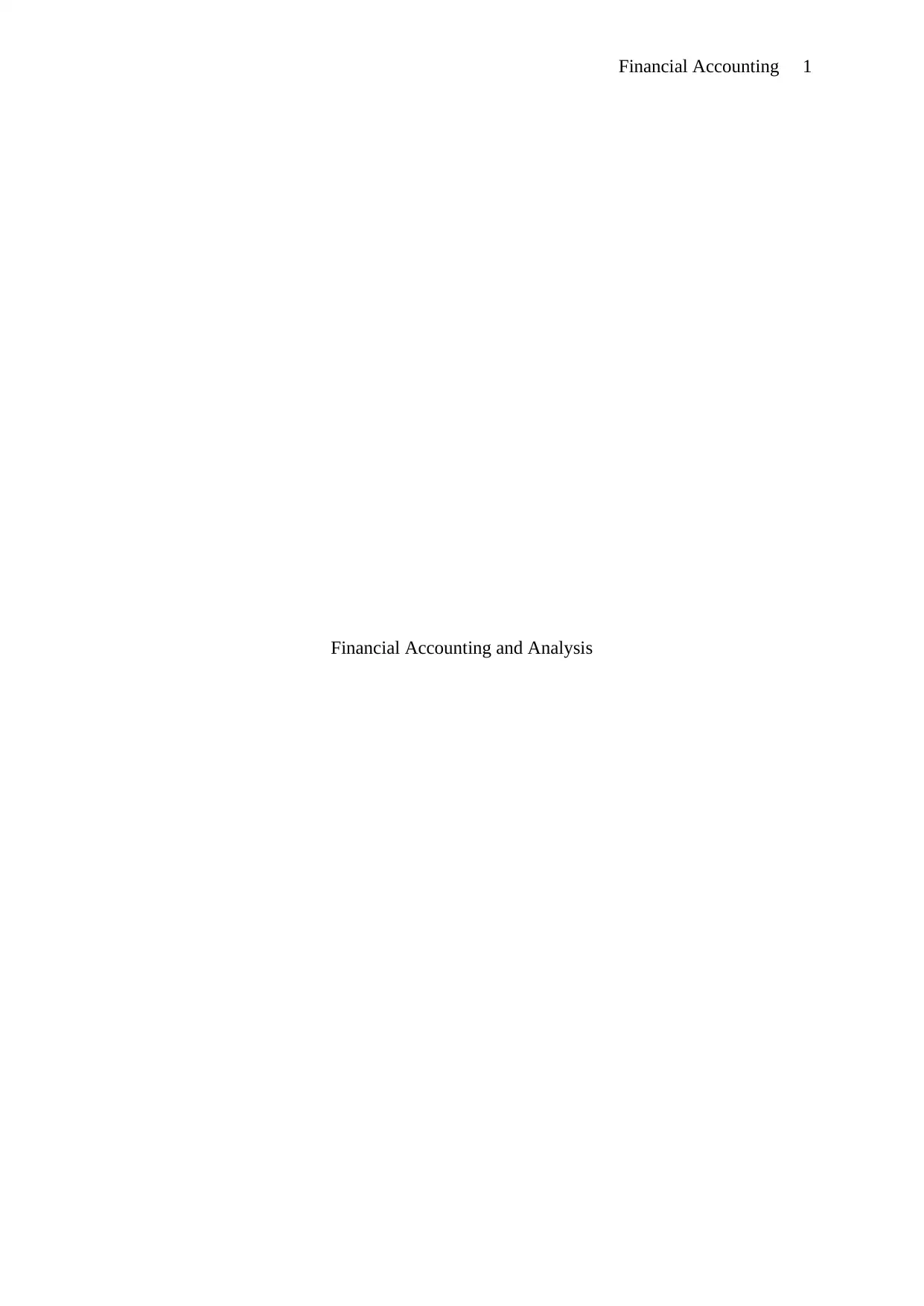
Financial Accounting 1
Financial Accounting and Analysis
Financial Accounting and Analysis
Paraphrase This Document
Need a fresh take? Get an instant paraphrase of this document with our AI Paraphraser
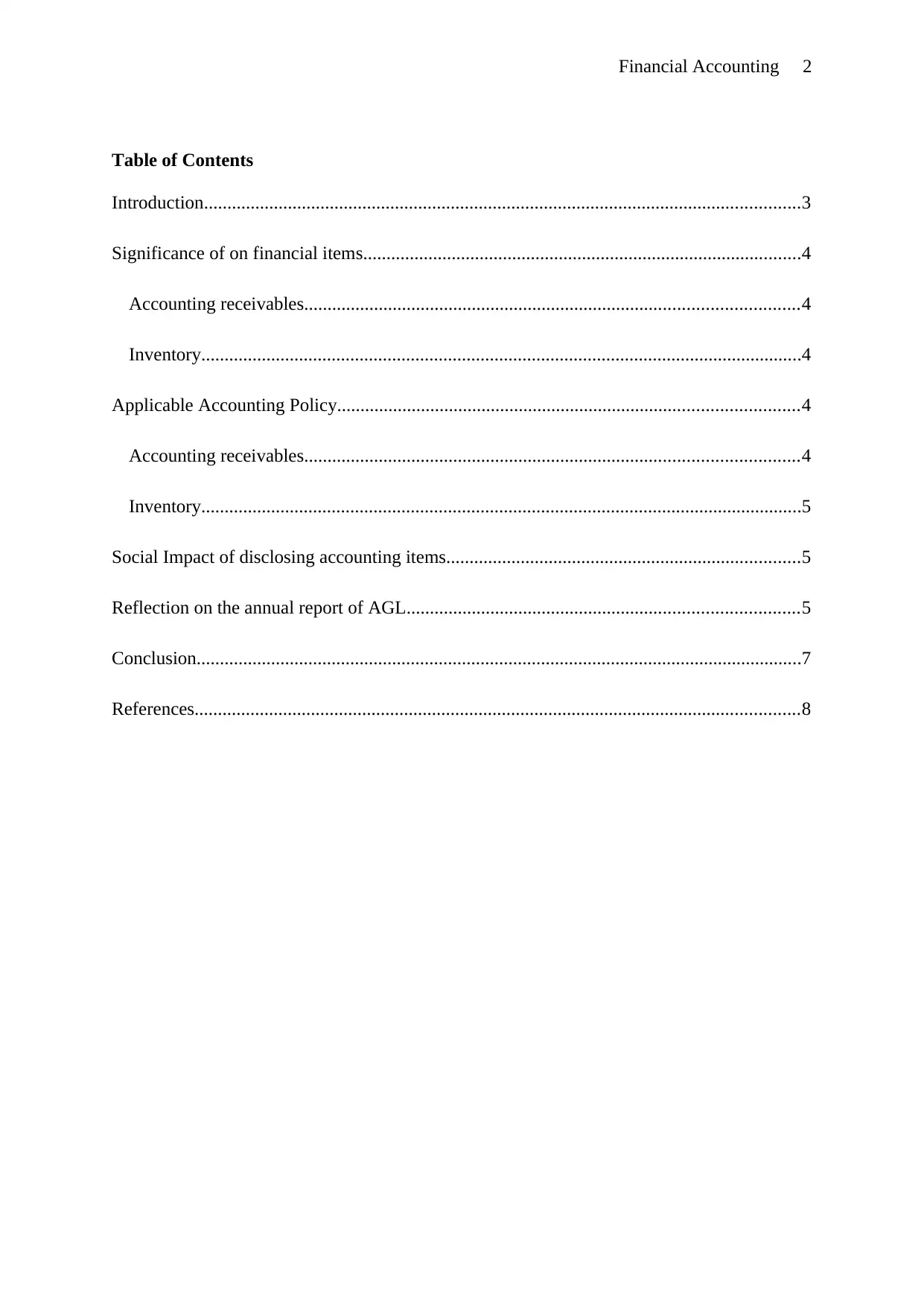
Financial Accounting 2
Table of Contents
Introduction................................................................................................................................3
Significance of on financial items..............................................................................................4
Accounting receivables..........................................................................................................4
Inventory.................................................................................................................................4
Applicable Accounting Policy...................................................................................................4
Accounting receivables..........................................................................................................4
Inventory.................................................................................................................................5
Social Impact of disclosing accounting items............................................................................5
Reflection on the annual report of AGL....................................................................................5
Conclusion..................................................................................................................................7
References..................................................................................................................................8
Table of Contents
Introduction................................................................................................................................3
Significance of on financial items..............................................................................................4
Accounting receivables..........................................................................................................4
Inventory.................................................................................................................................4
Applicable Accounting Policy...................................................................................................4
Accounting receivables..........................................................................................................4
Inventory.................................................................................................................................5
Social Impact of disclosing accounting items............................................................................5
Reflection on the annual report of AGL....................................................................................5
Conclusion..................................................................................................................................7
References..................................................................................................................................8
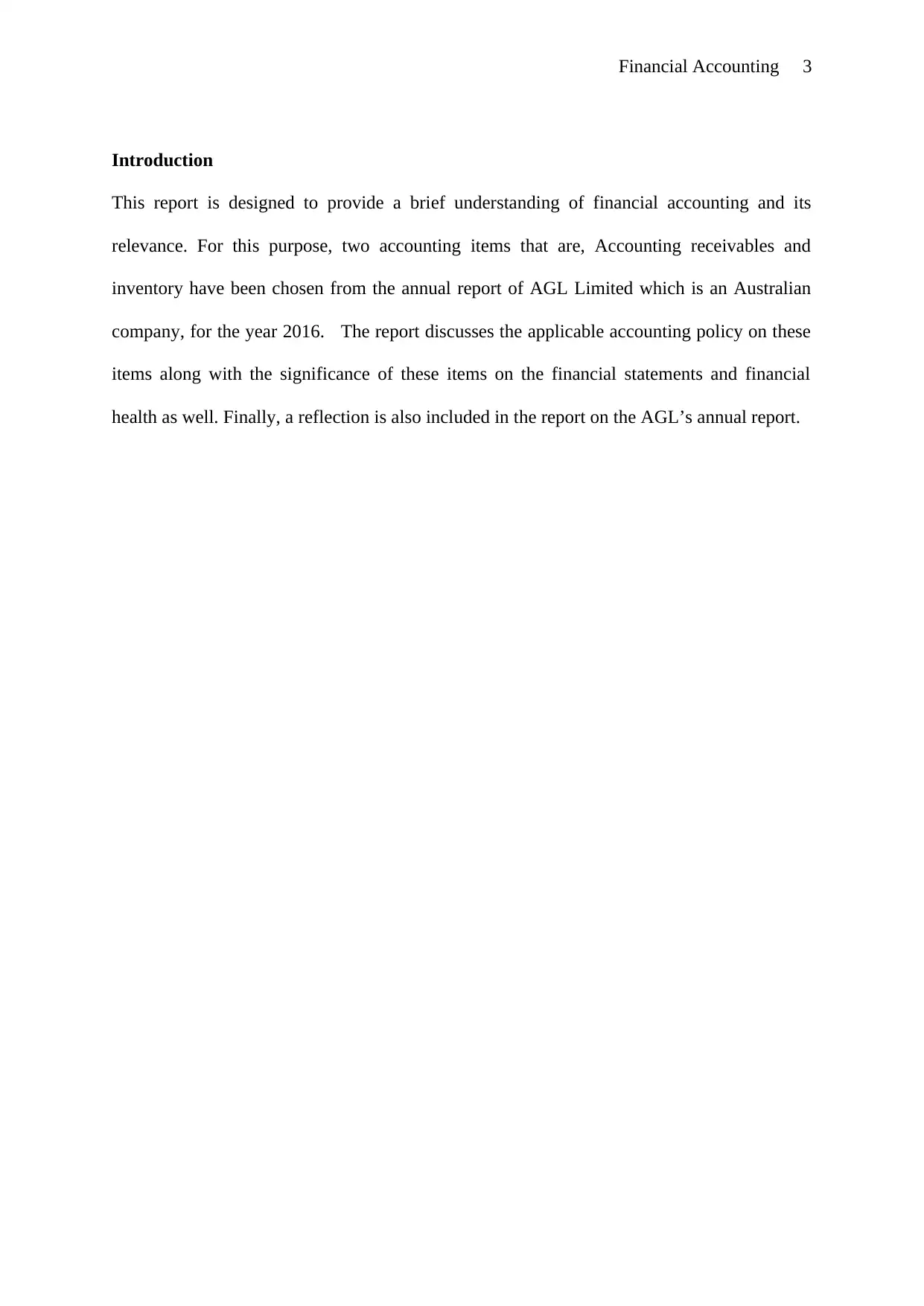
Financial Accounting 3
Introduction
This report is designed to provide a brief understanding of financial accounting and its
relevance. For this purpose, two accounting items that are, Accounting receivables and
inventory have been chosen from the annual report of AGL Limited which is an Australian
company, for the year 2016. The report discusses the applicable accounting policy on these
items along with the significance of these items on the financial statements and financial
health as well. Finally, a reflection is also included in the report on the AGL’s annual report.
Introduction
This report is designed to provide a brief understanding of financial accounting and its
relevance. For this purpose, two accounting items that are, Accounting receivables and
inventory have been chosen from the annual report of AGL Limited which is an Australian
company, for the year 2016. The report discusses the applicable accounting policy on these
items along with the significance of these items on the financial statements and financial
health as well. Finally, a reflection is also included in the report on the AGL’s annual report.
⊘ This is a preview!⊘
Do you want full access?
Subscribe today to unlock all pages.

Trusted by 1+ million students worldwide
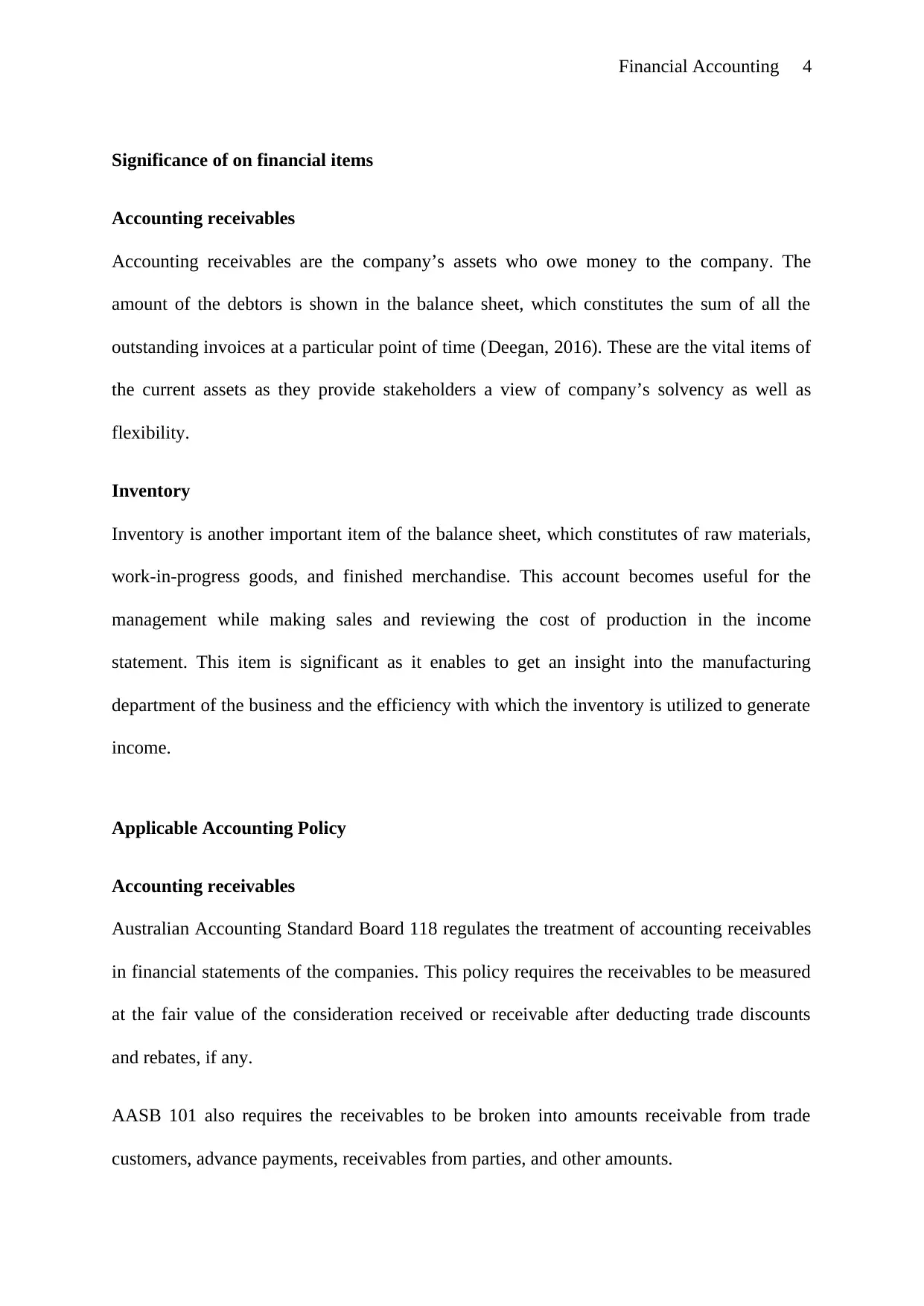
Financial Accounting 4
Significance of on financial items
Accounting receivables
Accounting receivables are the company’s assets who owe money to the company. The
amount of the debtors is shown in the balance sheet, which constitutes the sum of all the
outstanding invoices at a particular point of time (Deegan, 2016). These are the vital items of
the current assets as they provide stakeholders a view of company’s solvency as well as
flexibility.
Inventory
Inventory is another important item of the balance sheet, which constitutes of raw materials,
work-in-progress goods, and finished merchandise. This account becomes useful for the
management while making sales and reviewing the cost of production in the income
statement. This item is significant as it enables to get an insight into the manufacturing
department of the business and the efficiency with which the inventory is utilized to generate
income.
Applicable Accounting Policy
Accounting receivables
Australian Accounting Standard Board 118 regulates the treatment of accounting receivables
in financial statements of the companies. This policy requires the receivables to be measured
at the fair value of the consideration received or receivable after deducting trade discounts
and rebates, if any.
AASB 101 also requires the receivables to be broken into amounts receivable from trade
customers, advance payments, receivables from parties, and other amounts.
Significance of on financial items
Accounting receivables
Accounting receivables are the company’s assets who owe money to the company. The
amount of the debtors is shown in the balance sheet, which constitutes the sum of all the
outstanding invoices at a particular point of time (Deegan, 2016). These are the vital items of
the current assets as they provide stakeholders a view of company’s solvency as well as
flexibility.
Inventory
Inventory is another important item of the balance sheet, which constitutes of raw materials,
work-in-progress goods, and finished merchandise. This account becomes useful for the
management while making sales and reviewing the cost of production in the income
statement. This item is significant as it enables to get an insight into the manufacturing
department of the business and the efficiency with which the inventory is utilized to generate
income.
Applicable Accounting Policy
Accounting receivables
Australian Accounting Standard Board 118 regulates the treatment of accounting receivables
in financial statements of the companies. This policy requires the receivables to be measured
at the fair value of the consideration received or receivable after deducting trade discounts
and rebates, if any.
AASB 101 also requires the receivables to be broken into amounts receivable from trade
customers, advance payments, receivables from parties, and other amounts.
Paraphrase This Document
Need a fresh take? Get an instant paraphrase of this document with our AI Paraphraser
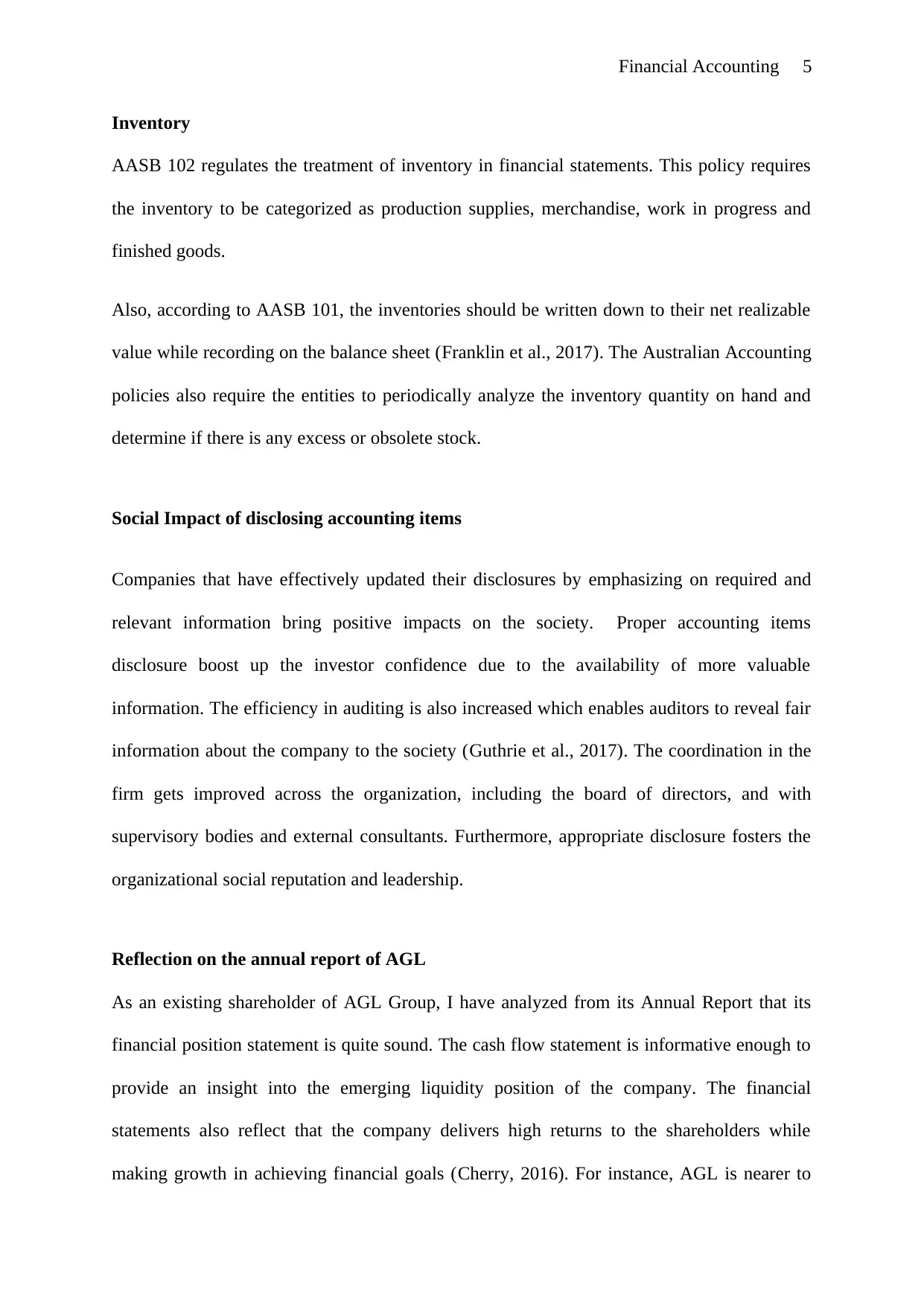
Financial Accounting 5
Inventory
AASB 102 regulates the treatment of inventory in financial statements. This policy requires
the inventory to be categorized as production supplies, merchandise, work in progress and
finished goods.
Also, according to AASB 101, the inventories should be written down to their net realizable
value while recording on the balance sheet (Franklin et al., 2017). The Australian Accounting
policies also require the entities to periodically analyze the inventory quantity on hand and
determine if there is any excess or obsolete stock.
Social Impact of disclosing accounting items
Companies that have effectively updated their disclosures by emphasizing on required and
relevant information bring positive impacts on the society. Proper accounting items
disclosure boost up the investor confidence due to the availability of more valuable
information. The efficiency in auditing is also increased which enables auditors to reveal fair
information about the company to the society (Guthrie et al., 2017). The coordination in the
firm gets improved across the organization, including the board of directors, and with
supervisory bodies and external consultants. Furthermore, appropriate disclosure fosters the
organizational social reputation and leadership.
Reflection on the annual report of AGL
As an existing shareholder of AGL Group, I have analyzed from its Annual Report that its
financial position statement is quite sound. The cash flow statement is informative enough to
provide an insight into the emerging liquidity position of the company. The financial
statements also reflect that the company delivers high returns to the shareholders while
making growth in achieving financial goals (Cherry, 2016). For instance, AGL is nearer to
Inventory
AASB 102 regulates the treatment of inventory in financial statements. This policy requires
the inventory to be categorized as production supplies, merchandise, work in progress and
finished goods.
Also, according to AASB 101, the inventories should be written down to their net realizable
value while recording on the balance sheet (Franklin et al., 2017). The Australian Accounting
policies also require the entities to periodically analyze the inventory quantity on hand and
determine if there is any excess or obsolete stock.
Social Impact of disclosing accounting items
Companies that have effectively updated their disclosures by emphasizing on required and
relevant information bring positive impacts on the society. Proper accounting items
disclosure boost up the investor confidence due to the availability of more valuable
information. The efficiency in auditing is also increased which enables auditors to reveal fair
information about the company to the society (Guthrie et al., 2017). The coordination in the
firm gets improved across the organization, including the board of directors, and with
supervisory bodies and external consultants. Furthermore, appropriate disclosure fosters the
organizational social reputation and leadership.
Reflection on the annual report of AGL
As an existing shareholder of AGL Group, I have analyzed from its Annual Report that its
financial position statement is quite sound. The cash flow statement is informative enough to
provide an insight into the emerging liquidity position of the company. The financial
statements also reflect that the company delivers high returns to the shareholders while
making growth in achieving financial goals (Cherry, 2016). For instance, AGL is nearer to
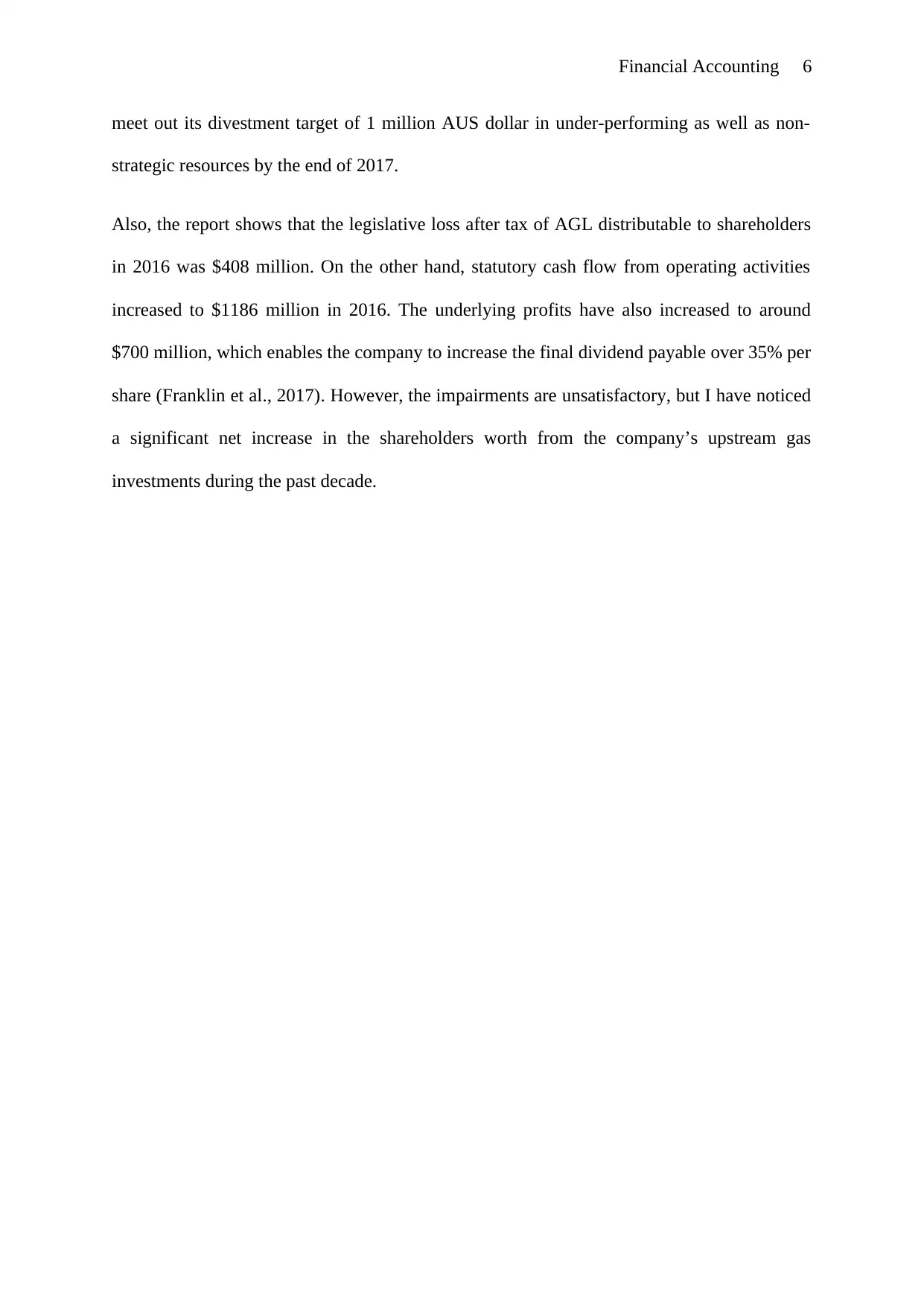
Financial Accounting 6
meet out its divestment target of 1 million AUS dollar in under-performing as well as non-
strategic resources by the end of 2017.
Also, the report shows that the legislative loss after tax of AGL distributable to shareholders
in 2016 was $408 million. On the other hand, statutory cash flow from operating activities
increased to $1186 million in 2016. The underlying profits have also increased to around
$700 million, which enables the company to increase the final dividend payable over 35% per
share (Franklin et al., 2017). However, the impairments are unsatisfactory, but I have noticed
a significant net increase in the shareholders worth from the company’s upstream gas
investments during the past decade.
meet out its divestment target of 1 million AUS dollar in under-performing as well as non-
strategic resources by the end of 2017.
Also, the report shows that the legislative loss after tax of AGL distributable to shareholders
in 2016 was $408 million. On the other hand, statutory cash flow from operating activities
increased to $1186 million in 2016. The underlying profits have also increased to around
$700 million, which enables the company to increase the final dividend payable over 35% per
share (Franklin et al., 2017). However, the impairments are unsatisfactory, but I have noticed
a significant net increase in the shareholders worth from the company’s upstream gas
investments during the past decade.
⊘ This is a preview!⊘
Do you want full access?
Subscribe today to unlock all pages.

Trusted by 1+ million students worldwide
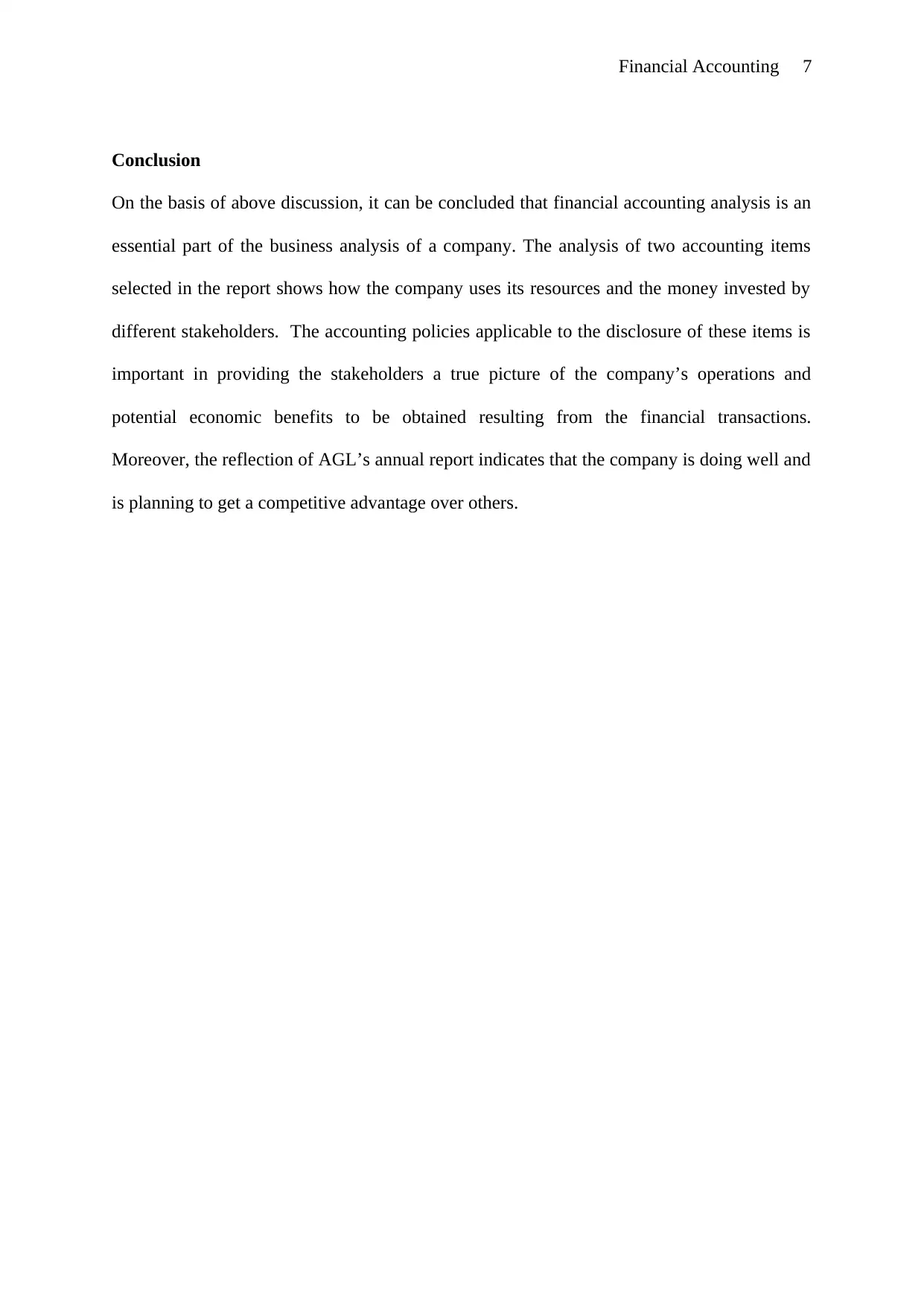
Financial Accounting 7
Conclusion
On the basis of above discussion, it can be concluded that financial accounting analysis is an
essential part of the business analysis of a company. The analysis of two accounting items
selected in the report shows how the company uses its resources and the money invested by
different stakeholders. The accounting policies applicable to the disclosure of these items is
important in providing the stakeholders a true picture of the company’s operations and
potential economic benefits to be obtained resulting from the financial transactions.
Moreover, the reflection of AGL’s annual report indicates that the company is doing well and
is planning to get a competitive advantage over others.
Conclusion
On the basis of above discussion, it can be concluded that financial accounting analysis is an
essential part of the business analysis of a company. The analysis of two accounting items
selected in the report shows how the company uses its resources and the money invested by
different stakeholders. The accounting policies applicable to the disclosure of these items is
important in providing the stakeholders a true picture of the company’s operations and
potential economic benefits to be obtained resulting from the financial transactions.
Moreover, the reflection of AGL’s annual report indicates that the company is doing well and
is planning to get a competitive advantage over others.
Paraphrase This Document
Need a fresh take? Get an instant paraphrase of this document with our AI Paraphraser
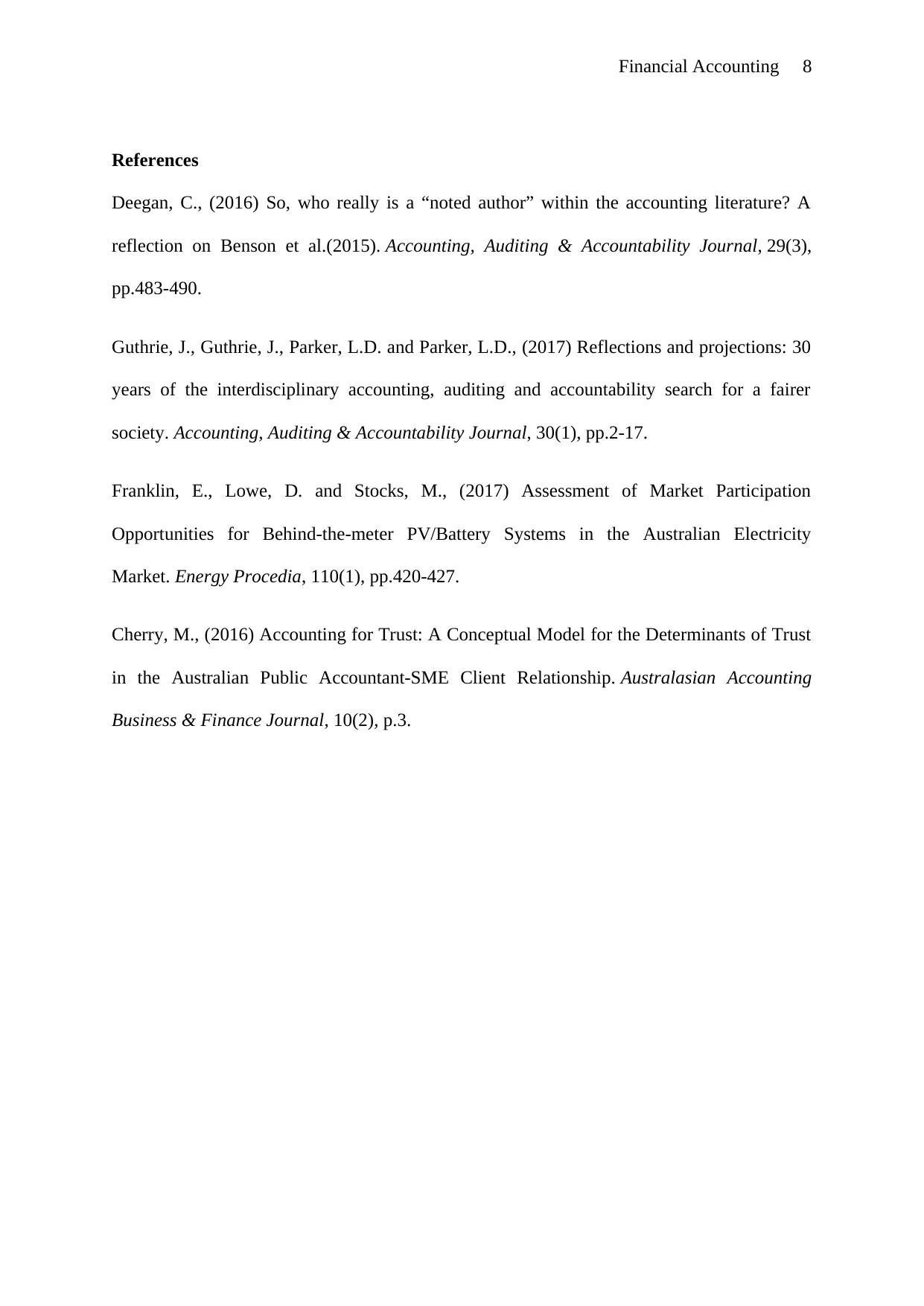
Financial Accounting 8
References
Deegan, C., (2016) So, who really is a “noted author” within the accounting literature? A
reflection on Benson et al.(2015). Accounting, Auditing & Accountability Journal, 29(3),
pp.483-490.
Guthrie, J., Guthrie, J., Parker, L.D. and Parker, L.D., (2017) Reflections and projections: 30
years of the interdisciplinary accounting, auditing and accountability search for a fairer
society. Accounting, Auditing & Accountability Journal, 30(1), pp.2-17.
Franklin, E., Lowe, D. and Stocks, M., (2017) Assessment of Market Participation
Opportunities for Behind-the-meter PV/Battery Systems in the Australian Electricity
Market. Energy Procedia, 110(1), pp.420-427.
Cherry, M., (2016) Accounting for Trust: A Conceptual Model for the Determinants of Trust
in the Australian Public Accountant-SME Client Relationship. Australasian Accounting
Business & Finance Journal, 10(2), p.3.
References
Deegan, C., (2016) So, who really is a “noted author” within the accounting literature? A
reflection on Benson et al.(2015). Accounting, Auditing & Accountability Journal, 29(3),
pp.483-490.
Guthrie, J., Guthrie, J., Parker, L.D. and Parker, L.D., (2017) Reflections and projections: 30
years of the interdisciplinary accounting, auditing and accountability search for a fairer
society. Accounting, Auditing & Accountability Journal, 30(1), pp.2-17.
Franklin, E., Lowe, D. and Stocks, M., (2017) Assessment of Market Participation
Opportunities for Behind-the-meter PV/Battery Systems in the Australian Electricity
Market. Energy Procedia, 110(1), pp.420-427.
Cherry, M., (2016) Accounting for Trust: A Conceptual Model for the Determinants of Trust
in the Australian Public Accountant-SME Client Relationship. Australasian Accounting
Business & Finance Journal, 10(2), p.3.
1 out of 8
Related Documents
Your All-in-One AI-Powered Toolkit for Academic Success.
+13062052269
info@desklib.com
Available 24*7 on WhatsApp / Email
![[object Object]](/_next/static/media/star-bottom.7253800d.svg)
Unlock your academic potential
Copyright © 2020–2025 A2Z Services. All Rights Reserved. Developed and managed by ZUCOL.





